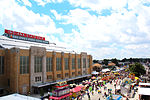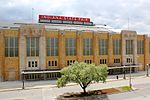Indiana State Fair stage collapse
2011 disasters in the United States2011 in Indiana2011 industrial disasters21st century in IndianapolisAccidental deaths in Indiana ... and 8 more
Building and structure collapses in 2011Building and structure collapses in the United StatesConcert disastersDisasters in IndianaFilmed deaths in the United StatesIndiana State FairSara BareillesUse mdy dates from January 2021
The Indiana State Fair stage collapse was an incident during an August 13, 2011, outdoor concert by Sugarland as part of their Incredible Machine Tour at the Indiana State Fair in which a wind gust from an approaching severe thunderstorm hit the stage's temporary roof structure, causing it to collapse. The structure landed among a crowd of spectators, killing seven people and injuring 58 others.The members of Sugarland were in a tour bus preparing to come on stage when the collapse occurred at 8:46 p.m. Opening act Sara Bareilles had completed her performance prior to the incident.
Excerpt from the Wikipedia article Indiana State Fair stage collapse (License: CC BY-SA 3.0, Authors).Indiana State Fair stage collapse
Coliseum Avenue, Indianapolis
Geographical coordinates (GPS) Address Nearby Places Show on map
Geographical coordinates (GPS)
| Latitude | Longitude |
|---|---|
| N 39.82995 ° | E -86.134355555556 ° |
Address
Coliseum Avenue
46205 Indianapolis
Indiana, United States
Open on Google Maps







